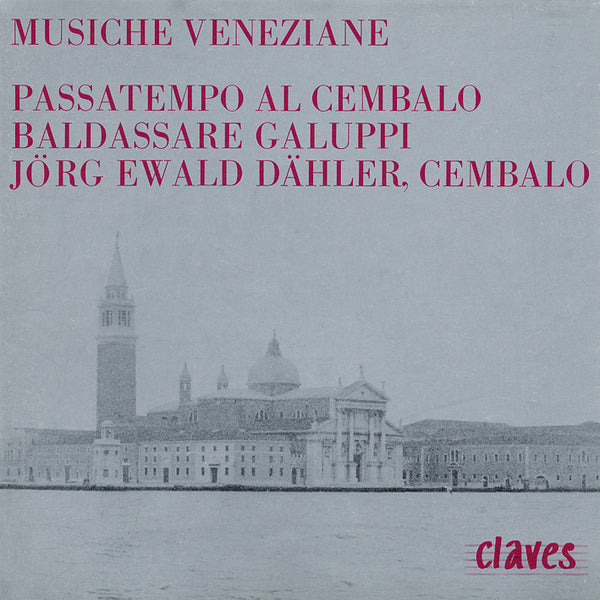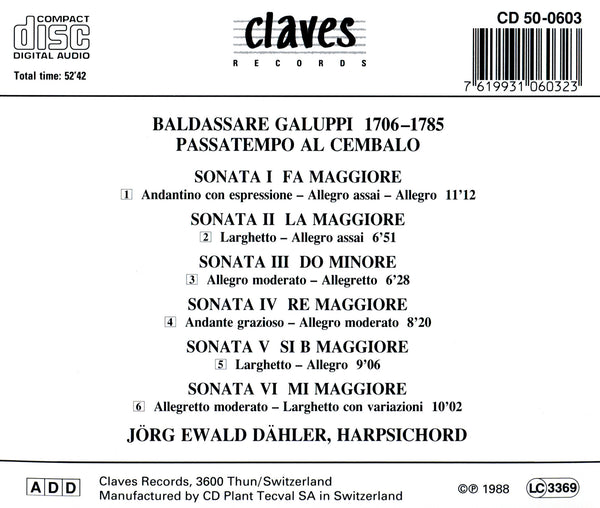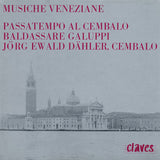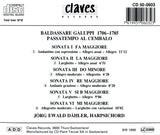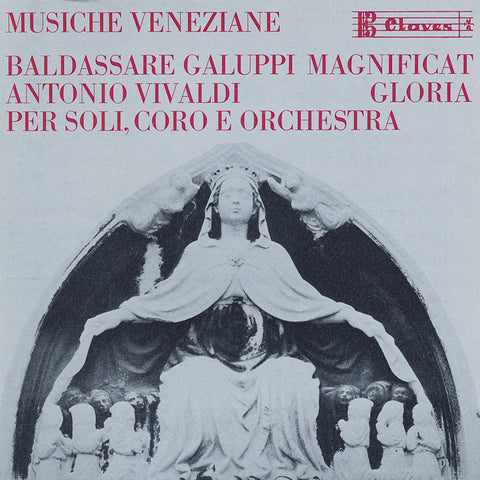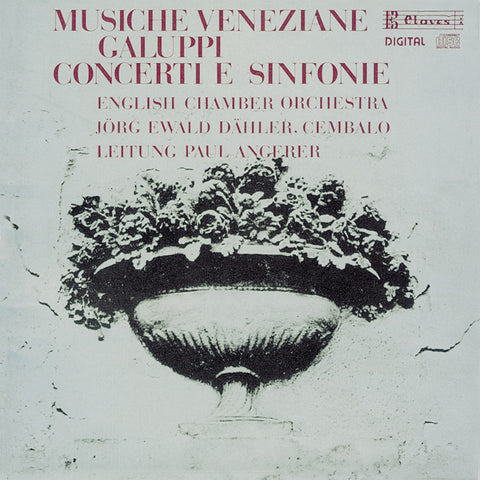(1988) Baldassare Galuppi: Passatempo Al Cembalo
Category(ies): Ancient music
Instrument(s): Harpischord
Main Composer: Baldassare Galuppi
CD set: 1
Catalog N°:
CD 0603
Release: 1988
EAN/UPC: 7619931060323
- UPC: 829410602266
This album is now on repressing. Pre-order it at a special price now.
CHF 18.50
This album is no longer available on CD.
This album has not been released yet. Pre-order it from now.
CHF 18.50
This album is no longer available on CD.
This album is no longer available on CD.
VAT included for Switzerland & UE
Free shipping
This album is now on repressing. Pre-order it at a special price now.
CHF 18.50
This album is no longer available on CD.
This album has not been released yet.
Pre-order it at a special price now.
CHF 18.50
This album is no longer available on CD.
This album is no longer available on CD.
BALDASSARE GALUPPI: PASSATEMPO AL CEMBALO
If I want to find another word for music it is again and again Venice - Nietzsche.
Baldassare galuppi was born on the island of Burano, near Venice. His long and busy life was spent mostly in the picturesque world of the Thatre among singers and impresario. His family was poor, his father – a violinist – also worked as a barber. At the early age of sixteen the young Baldassare had already composed his opera ‘La fede nell’inconstanza’. Later on he began to study music seriously with Antonio Lotti, at that time premier organ player of San Marco.
Of the more than a hundred operas which Galuppi composed ‘Il filosofo di campagna’ is the only one well-known today. It comes as a surprise to both musicians and the public that instrumental works of his are being discovered today. These were often composed for various occasions and reveal a quite different Galuppi from the gallant composer of opera and show him to have been – especially for the harpsichord – a master in the development of the sonata form.
The six sonatas of the ‘Passatempo al cembalo’ – a pastime at the harpsichord – have (apart from the first one) only two movements. The first page of this work carries the date 1781, so it was composed during the last working period of the master. It is very likely the sonatas were especially composed on the occasion of the visit of the Russian Prince Paolo Petrovich and his consort Princess Theodorovna to Venice and to whom Galuppi was known from his years spent at the Court of the Empress Katharina II in St. Petersburg (1765-1768). It is interesting to know that Galuppi condemned the introduction of ‘buffo-thematic’ into instrumental music. This shows his seriousness towards symphonic works and chamber music, whereas nearly all other opera composers of that time looked upon them as second-class.
Most of these harpsichord sonatas which seem to anticipate Haydn and Mozart, begin with an ‘Andante’ or ‘Moderato’. The structure of the movements is mostly bi-thematic. They have three parts, the transition from one to the other being marked by clear bridge passages. Motives and rhythm often remind one of dances from a baroque ‘Suite’. The Allegro at the end of the first sonata for instance, is a perfectly symmetrical minuet. The sixth sonata in E Minor ends with a theme and six variations of greater concentration. The high degree of technical difficulty corresponds with the high degree of technical difficulty corresponds with the high standard of the master-players of the time. Like Scarlatti, Galuppi also uses the crossing of the hands, especially in the last movement of the fifth sonata.
Finally, we want to explain the dislike of many musicians for the pianoforte – an instrument which had been in existence for quite a long time when the ‘Passatempo al cembalo’ was composed. But it is quite natural that a virtuoso on the harpsichord like Galuppi only with reluctance leaves an instrument which is so well known to him. Besides – the technical qualities of the pianofortes at that time were still incomplete and could not compare with the approved keyboard of a harpsichord. But without giving up that glorious instrument many composers – and Galuppi was one of them – searched for a new possibility of expression, finding this especially in the pianoforte’s variability of touch combined with the effect of the pedals.
(1988) Baldassare Galuppi: Passatempo Al Cembalo - CD 0603
If I want to find another word for music it is again and again Venice - Nietzsche.
Baldassare galuppi was born on the island of Burano, near Venice. His long and busy life was spent mostly in the picturesque world of the Thatre among singers and impresario. His family was poor, his father – a violinist – also worked as a barber. At the early age of sixteen the young Baldassare had already composed his opera ‘La fede nell’inconstanza’. Later on he began to study music seriously with Antonio Lotti, at that time premier organ player of San Marco.
Of the more than a hundred operas which Galuppi composed ‘Il filosofo di campagna’ is the only one well-known today. It comes as a surprise to both musicians and the public that instrumental works of his are being discovered today. These were often composed for various occasions and reveal a quite different Galuppi from the gallant composer of opera and show him to have been – especially for the harpsichord – a master in the development of the sonata form.
The six sonatas of the ‘Passatempo al cembalo’ – a pastime at the harpsichord – have (apart from the first one) only two movements. The first page of this work carries the date 1781, so it was composed during the last working period of the master. It is very likely the sonatas were especially composed on the occasion of the visit of the Russian Prince Paolo Petrovich and his consort Princess Theodorovna to Venice and to whom Galuppi was known from his years spent at the Court of the Empress Katharina II in St. Petersburg (1765-1768). It is interesting to know that Galuppi condemned the introduction of ‘buffo-thematic’ into instrumental music. This shows his seriousness towards symphonic works and chamber music, whereas nearly all other opera composers of that time looked upon them as second-class.
Most of these harpsichord sonatas which seem to anticipate Haydn and Mozart, begin with an ‘Andante’ or ‘Moderato’. The structure of the movements is mostly bi-thematic. They have three parts, the transition from one to the other being marked by clear bridge passages. Motives and rhythm often remind one of dances from a baroque ‘Suite’. The Allegro at the end of the first sonata for instance, is a perfectly symmetrical minuet. The sixth sonata in E Minor ends with a theme and six variations of greater concentration. The high degree of technical difficulty corresponds with the high degree of technical difficulty corresponds with the high standard of the master-players of the time. Like Scarlatti, Galuppi also uses the crossing of the hands, especially in the last movement of the fifth sonata.
Finally, we want to explain the dislike of many musicians for the pianoforte – an instrument which had been in existence for quite a long time when the ‘Passatempo al cembalo’ was composed. But it is quite natural that a virtuoso on the harpsichord like Galuppi only with reluctance leaves an instrument which is so well known to him. Besides – the technical qualities of the pianofortes at that time were still incomplete and could not compare with the approved keyboard of a harpsichord. But without giving up that glorious instrument many composers – and Galuppi was one of them – searched for a new possibility of expression, finding this especially in the pianoforte’s variability of touch combined with the effect of the pedals.
Return to the album | Composer(s): Baldassare Galuppi | Main Artist: Jörg Ewald Dähler







